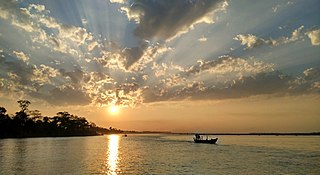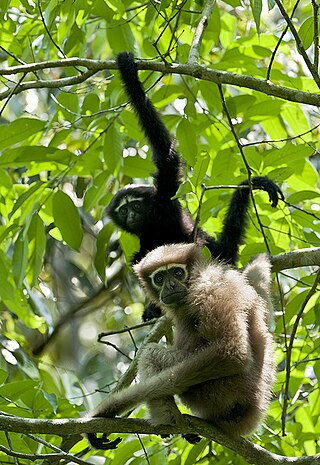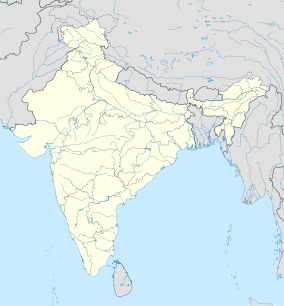
The white-winged duck or white-winged wood duck is a large species of duck, formerly placed in the genus Cairina with the Muscovy duck and allied with the dabbling ducks. However, mtDNA cytochrome b and NADH dehydrogenase subunit 2 sequence analysis indicate that the anatomical similarity to the Muscovy duck is deceiving and that the species is appropriately placed in a monotypic genus, as Asarcornis scutulata, which is evolutionarily closer to the redhead.

Dibru-Saikhowa National Park is a national park located in Dibrugarh and Tinsukia districts, Assam, India. It was designated a Biosphere Reserve in July 1997 with an area of 765 km2 (295 sq mi), including a core area of 340 km2 (130 sq mi) and a buffer zone of 425 km2 (164 sq mi).

Tinsukia district is one of the 34 administrative districts in the state of Assam, India. The district headquarters is located at Tinsukia city. The district occupies an area of 3790 km2.

The Brahmaputra Valley semi-evergreen forests is a tropical moist broadleaf forest ecoregion of Northeastern India, southern Bhutan and adjacent Bangladesh.

Namdapha National Park is a 1,985 km2 (766 sq mi) large protected area in Arunachal Pradesh of Northeast India. The park was established in 1983. With more than 1,000 floral and about 1,400 faunal species, it is a biodiversity hotspot in the Eastern Himalayas. The national park harbours the northernmost lowland evergreen rainforests in the world at 27°N latitude. It also harbours extensive dipterocarp forests, comprising the northwestern parts of the Mizoram-Manipur-Kachin rain forests ecoregion.

Manas National Park is a national park, Project Tiger reserve, and an elephant reserve in Assam, India. Located in the Himalayan foothills, it borders the Royal Manas National Park in Bhutan. The park is known for its rare and endangered endemic wildlife such as the Assam roofed turtle, hispid hare, golden langur and pygmy hog. Manas is also famous for its population of the wild water buffalo. Because of its exceptional biodiversity, scenery, and variety of habitats, Manas National Park is a biosphere reserve and a UNESCO World Heritage Site.

The biodiversity of Assam, a state in North-East India, makes it a biological hotspot with many rare and endemic plant and animal species. The greatest success in recent years has been the conservation of the Indian rhinoceros at the Kaziranga National Park, but a rapid increase in human population in Assam threatens many plants and animals and their natural habitats.

Eaglenest or Eagle's Nest Wildlife Sanctuary is a protected area of India in the Himalayan foothills of West Kameng District, Arunachal Pradesh. It conjoins Sessa Orchid Sanctuary to the northeast and Pakhui Tiger Reserve across the Kameng river to the east. Altitude ranges are extreme: from 500 metres (1,640 ft) to 3,250 metres (10,663 ft). It is a part of the Kameng Elephant Reserve.

The Hollongapar Gibbon Sanctuary, formerly known as the Gibbon Wildlife Sanctuary or Hollongapar Reserved Forest, is an isolated protected area of evergreen forest located in Assam, India. The sanctuary was officially constituted and renamed in 1997. Set aside initially in 1881, its forests used to extend to the foothills of the Patkai mountain range.
Pakke Tiger Reserve, is a Project Tiger reserve in the East Kameng district of Arunachal Pradesh in Northeast India. The 862 km2 (333 sq mi) reserve is protected by the Department of Environment and Forest of Arunachal Pradesh. It was known as Pakhui Tiger Reserve, but renamed in April 2001 by the Governor of Arunachal Pradesh. It has won India Biodiversity Award 2016 in the category of 'Conservation of threatened species' for its Hornbill Nest Adoption Programme.
Nature's Beckon is an independent environmental activist group in Northeast India which initiated the environmental movement in Assam.

Anwaruddin Choudhury is an Indian naturalist, noted for his expertise on the fauna of North-East India.
Nambor Wildlife Sanctuary is a protected area located in Karbi Anglong district of Assam in India. This wildlife sanctuary covers an area of 37 km2. The area was declared as a sanctuary on 27 July 2000. It is located 25 km from Golaghat district and 65 km from the Kaziranga National Park. Together with Garampani Wildlife Sanctuary of Karbi Anglong and Nambor-Doigrung Wildlife Sanctuary of Golaghat district it forms a larger complex of wilderness. The proposal for this sanctuary was made in 1993.
Nambor - Doigrung Wildlife Sanctuary is a Morangi located in Golaghat district of Assam in India. This wildlife sanctuary covers an area of 97.15 km2. It is located 25 km from Golaghat town and about 318 km from Guwahati LGBI Airport. The forest type is tropical semi-evergreen with pockets of pure evergreen, interspersed with small forest marshes. The area was declared as a Wildlife sanctuary in 2003. The sanctuary along with Garampani Wildlife Sanctuary and Nambor Wildlife Sanctuary (37 km2) are a part of the Kaziranga-Karbi Anglong Elephant Reserve, which was declared on 17 April 2003, with an estimated area of 3,270 km2.
Pani-Dihing Bird Sanctuary is a 33.93-square-kilometre (13.10 sq mi) bird sanctuary located in Sivasagar district, Assam. It is 22 km (14 mi) away from Sivasagar town. This protected area was established as a Bird Sanctuary in August 1996 by the Government of Assam. It was identified as a potential bird sanctuary in late 1980s. The first systematic ornithological surveys in the area was conducted by noted conservationist Dr Anwaruddin Choudhury in 1987-88. Pani-Dihing is a complex of grassland and wetland. Some of the wetlands including channels or beels include Tokia, Jarjaria, Boloma, Dighali, Singorajan, Sagunpora, Kandhulijan, Fulai and Gaiguma. A detailed background of Pani-Dihing has also been published. Pani-Dihing and adjacent areas is on the global map being an Important Bird & Biodiversity Area
BARAIL Wildlife Sanctuary is located in the southern part of Assam, India, in the Cachar district, and lies between 24°55΄53΄΄-25°05΄52΄΄ N latitude and 92°27΄40΄΄-93°04΄30΄΄ E longitude. The Dima Hasao part of Barail is not part of this sanctuary. The altitude ranges between 55–1500 m above mean sea level. It spreads over 326.24 km2. The annual average rainfall and temperature range from 2500–4000 mm and 9.2 °C to 36.2 °C respectively; the humidity varies from 62% to 83%. Fieldworks in the Barail area were proposed as a national park or sanctuary in the 1980s.
Assam – 16th largest, 15th most populous and 26th most literate state of the 28 states of the democratic Republic of India. Assam is at 14th position in life expectancy and 8th in female-to-male sex ratio. Assam is the 21st most media exposed states in India. The Economy of Assam is largely agriculture based with 69% of the population engaged in it. Growth rate of Assam's income has not kept pace with that of India's during the Post-British Era; differences increased rapidly since the 1970s. While the Indian economy grew at 6 percent per annum over the period of 1981 to 2000, the same of Assam's grew only by 3.3 percent.
The Amchang Wildlife Sanctuary is a wildlife sanctuary located on the eastern fringe of Guwahati, Assam, India. The sanctuary is known for hosting rare and endangered birds and animals. Amchang's habitat is dominated by tropical moist deciduous forest with semi-evergreen forest in depressions and river-valleys. It is known for its elephants which have become isolated with no movement with other elephant-populations. The first published information of these elephants was found in 1985 There were depredations in the fringe areas, which are part of Guwahati city, the capital of Assam. It was acute as the pachyderms were confined to an isolated forest not very large. Hence, a protected area was mooted. The wild elephants from Amchang often enter parts of Guwahati City but on a few occasions they travelled to the heart of the city. The sanctuary has other mammals such as Chinese pangolin, slow loris, Assamese macaque, rhesus monkey, hoolock gibbon, leopard, leopard cat, jungle cat, sambar, barking deer, red serow, Malayan giant squirrel, crestless Himalayan porcupine. However, it is the presence of an isolated population of gaur or Indian "bison" that has added significance to Amchang. This bovid is also confined to this sanctuary with no links to other areas. Amchang is an Important Bird & Biodiversity Area. The sanctuary has a diverse birdlife. Some noteworthy species found includes White-backed vulture, Slender-billed vulture, White-cheeked hill partridges, Grey peacock pheasant, Kaleej pheasant, Greater adjutant stork mostly in flight, Great pied hornbill, Oriental pied hornbill and Green imperial pigeon among many others. Prior to 2004, the area was made up of three individual reserved forests, the Amchang reserved forest, South Amchang reserved forest and Khanapara reserved forest. These three forests were combined in 2004 by the Assam government to form the sanctuary as it exists today. It is spread over in an area of 78.64 square kilometre
Dehing Patkai Landscape, located in the Upper Assam, stretches for over roughly 600 square kilometres and comprises three large blocks of forests and several forest fragments. The forest is classified as a lowland Tropical Wet Evergreen Forest (Dipterocarpus-Mesua). It falls under Indo-Burma Biodiversity Hotspot. Due to its biodiversity and significance for elephant habitat, parts of the landscape are recognised as Dehing Patkai Elephant Reserve and 111 km2 is protected as the Dehing Patkai Wildlife Sanctuary since 2004.

Raimona National Park is located in extreme western part of Assam, India. It is spread across Gossaigaon and Kokrajhar subdivisions of Kokrajhar district of Bodoland Territorial Region.
















